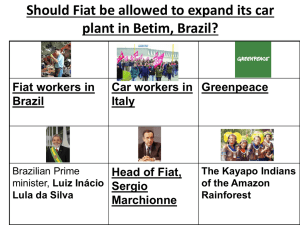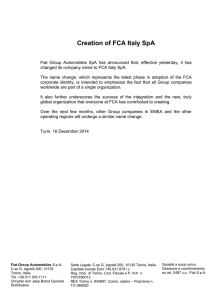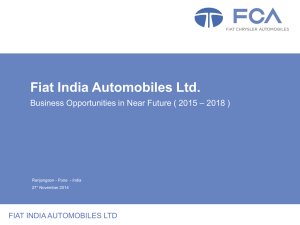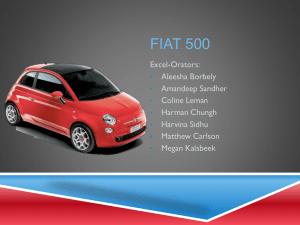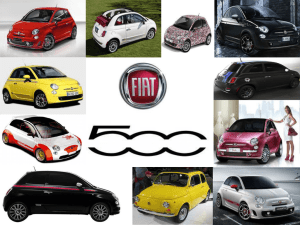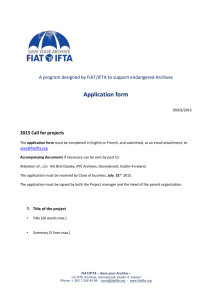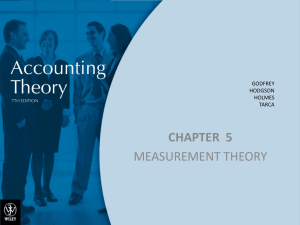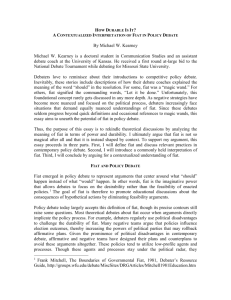Fiat and GM: The Troubled Alliance
advertisement
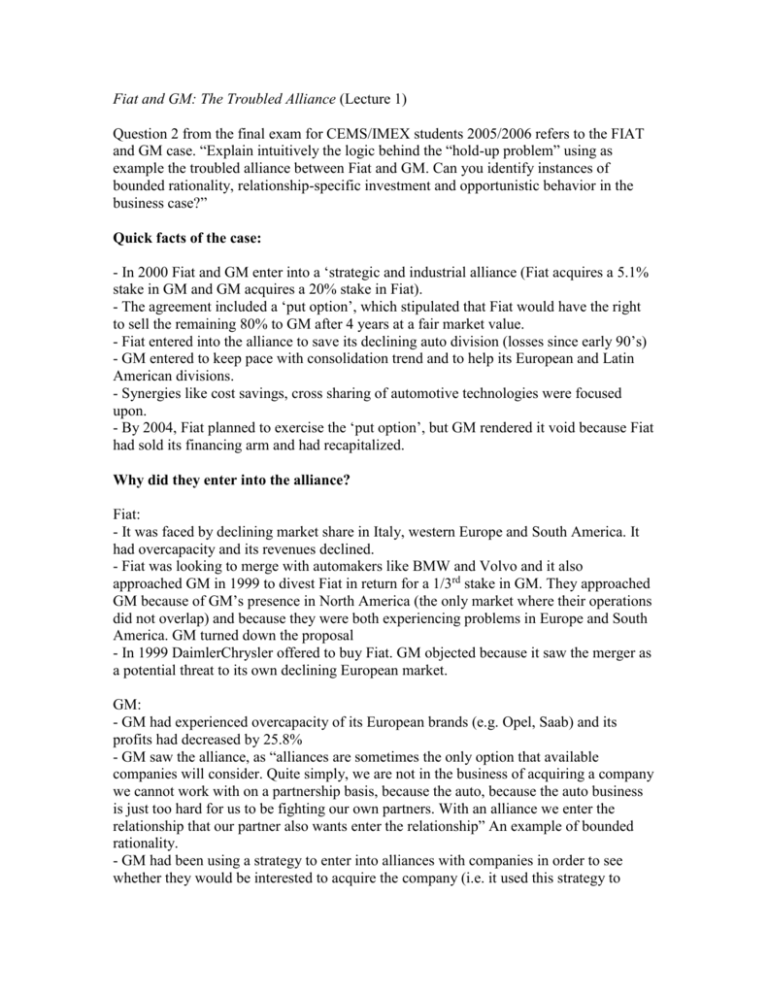
Fiat and GM: The Troubled Alliance (Lecture 1) Question 2 from the final exam for CEMS/IMEX students 2005/2006 refers to the FIAT and GM case. “Explain intuitively the logic behind the “hold-up problem” using as example the troubled alliance between Fiat and GM. Can you identify instances of bounded rationality, relationship-specific investment and opportunistic behavior in the business case?” Quick facts of the case: - In 2000 Fiat and GM enter into a ‘strategic and industrial alliance (Fiat acquires a 5.1% stake in GM and GM acquires a 20% stake in Fiat). - The agreement included a ‘put option’, which stipulated that Fiat would have the right to sell the remaining 80% to GM after 4 years at a fair market value. - Fiat entered into the alliance to save its declining auto division (losses since early 90’s) - GM entered to keep pace with consolidation trend and to help its European and Latin American divisions. - Synergies like cost savings, cross sharing of automotive technologies were focused upon. - By 2004, Fiat planned to exercise the ‘put option’, but GM rendered it void because Fiat had sold its financing arm and had recapitalized. Why did they enter into the alliance? Fiat: - It was faced by declining market share in Italy, western Europe and South America. It had overcapacity and its revenues declined. - Fiat was looking to merge with automakers like BMW and Volvo and it also approached GM in 1999 to divest Fiat in return for a 1/3rd stake in GM. They approached GM because of GM’s presence in North America (the only market where their operations did not overlap) and because they were both experiencing problems in Europe and South America. GM turned down the proposal - In 1999 DaimlerChrysler offered to buy Fiat. GM objected because it saw the merger as a potential threat to its own declining European market. GM: - GM had experienced overcapacity of its European brands (e.g. Opel, Saab) and its profits had decreased by 25.8% - GM saw the alliance, as “alliances are sometimes the only option that available companies will consider. Quite simply, we are not in the business of acquiring a company we cannot work with on a partnership basis, because the auto, because the auto business is just too hard for us to be fighting our own partners. With an alliance we enter the relationship that our partner also wants enter the relationship” An example of bounded rationality. - GM had been using a strategy to enter into alliances with companies in order to see whether they would be interested to acquire the company (i.e. it used this strategy to acquire Saab and Isuzu Motors). These acquisitions have not been very successful. Investors saw less of a gain from the alliance for GM than for Fiat. - The alliance sought to achieve cost savings through a common purchasing strategy (with the aim to achieve cost savings of 2 billion euro’s by 2005). It also aimed to share technological know-how of diesel engines. - Seeing that the auto industry is an oligopolistic market Fiat was not allowed to enter into other alliances if it sought to divest its auto arm. How did the alliance unfold? - There were some synergies realized, such as global sourcing. However, in 2001 the terrorist attacks in New York led to a significant fall in orders for Fiat. By 2002 they incurred an operating loss of $404 million and by mid-2002 it had a net debt of $6 billion. - Fiat became interested in selling its auto arm to GM through the put option. GM showed disinterest because of Fiat’s beleaguered financial position. Fiat’s decline continued as sales dropped, capacity utilization fell, and high warranty costs. In 2002 both Fiat and GM sought to cut their losses and closed factories and laid off workers. - Despite cost-cutting GM found itself running out of cash ($9 billion pension fund liability and $47 billion of healthcare costs). - End of 2002 GM wrote down its investment in Fiat from $2.4 billion to $220 million, which illustrated its reluctance to buy Fiat. - End of 2002 Fiat re-capitalized. Selling its GM shares to Merrill Lynch and selling its stake in an energy consortium and it sold its financing arm. - A professor of auto industry economics said “Eventually, Fiat cannot stay on its own. That has nothing to do with Fiat but with the economies of car making.” Fiat needed 5 billion euros. Its parent company invested 3 and it turned to GM for the rest. GM refused and its stake was subsequently reduced to 10%. - It was opinioned that GM would only agree if Fiat would rescue it from the obligatory put option or give a considerable return for its investment. Fiat was however determined to save its auto division and did not want to exercise the put option yet. Fiat restructured again and made a small profit in mid-2004. End of the alliance - Mid-2004 GM agreed to help Fiat out of its financial turbulence. However, by end 2004 there were speculations that GM was seeking to sell its stake in Fiat and deny the obligation of the put option. - GM argued that the put option was void because Fiat had sold its financing arm Fidis. Fiat countered by saying GM could buyout 51% of Fidis and that Fiat’s strategic freedom was restricted because the alliance between GM and Fiat stipulated that Fiat could not enter into alliances with others (relationship-specific investment). - Fiat agreed to cancel the put option if GM paid $3 billion, but GM only agreed to pay up to the book value of its stake, which was $500 million. Many were of the opinion that simply pumping cash into Fiat would not save its declining market share, but the Fiat owners were not keen to sell Fiat (also seeing that it was politically sensitive). Some points of analysis I think in this case we can distill several examples of bounded rationality, relationshipspecific investments, and opportunistic behavior. Bounded rationality: - GM thought the key points of the agreement were cost savings and technology sharing (i.e. being able to produce small cars and learn about diesel technology). For Fiat it seemed more about finding an eventual party to merge with. - GM did not anticipate Fiat selling its financing arm and its huge losses and future debt. - Contingencies such as 9/11 taking place and perhaps a misjudgment of the economics of the auto industry by both parties (i.e. Fiat being too small to be on its own) could have led to contingencies after the alliance was created (transaction-cost theory). Relationship-specific investment: - GM sunk a $2.4 billion investment and agreed to the put option. - Fiat agreed not to enter into other ‘strategic alliances’. Opportunistic behavior: - Fiat recapitalized, selling its financing arm Fidis. - Fiat used the put option as a way to hold up GM by leaving it no choice but to buy. - GM sought to use the new information that Fiat re-capitalized to hold up Fiat by declaring the put option void (i.e. Fiat had invested into the agreement and hence would have to abide to it).
